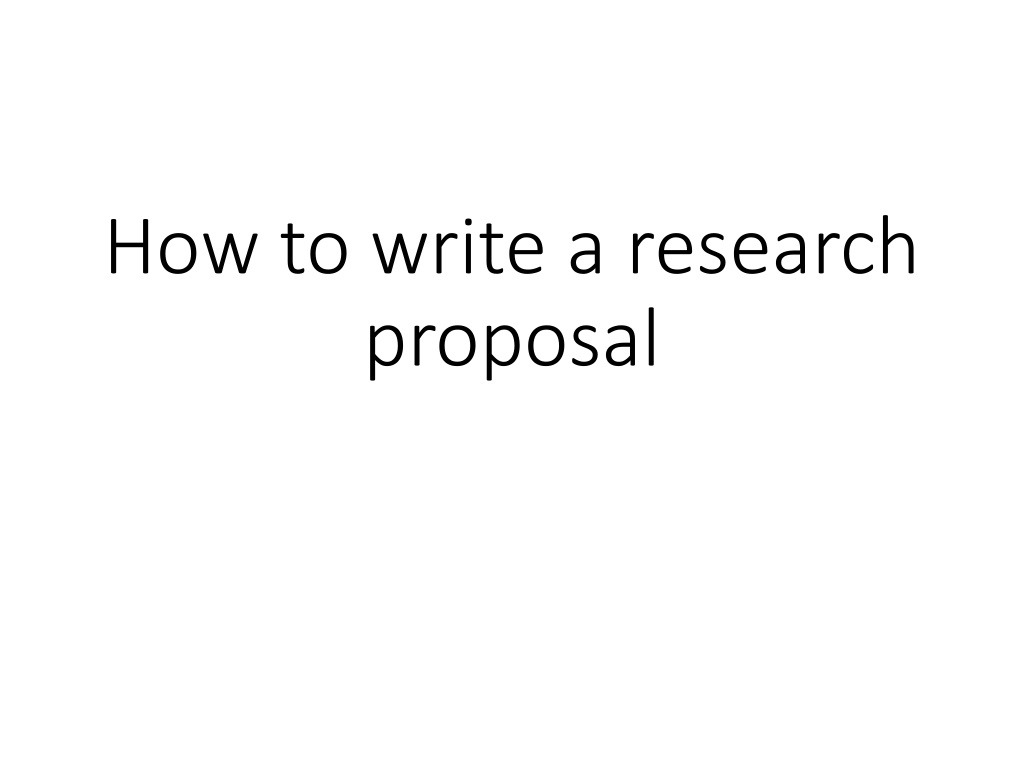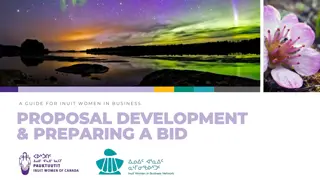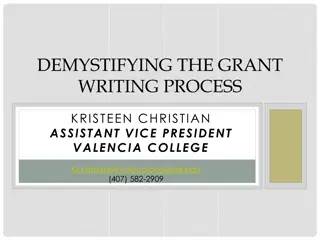Writing a Research Proposal: Purpose and Elements
Crafting a research proposal involves convincing reviewers of addressing knowledge gaps with necessary tools. Learn about the proposal's purpose, key elements like introduction, background, hypotheses, proposed work, and more. Understand the significance of adhering to specific guidelines to enhance proposal acceptance rates. Dive into the essential steps to introduce your research area effectively and provide background information, ensuring the proposal's clarity and coherence.
Download Presentation

Please find below an Image/Link to download the presentation.
The content on the website is provided AS IS for your information and personal use only. It may not be sold, licensed, or shared on other websites without obtaining consent from the author.If you encounter any issues during the download, it is possible that the publisher has removed the file from their server.
You are allowed to download the files provided on this website for personal or commercial use, subject to the condition that they are used lawfully. All files are the property of their respective owners.
The content on the website is provided AS IS for your information and personal use only. It may not be sold, licensed, or shared on other websites without obtaining consent from the author.
E N D
Presentation Transcript
How to write a research proposal
What is the purpose of a proposal? To convince reviewers (or your PhD committee) that: there is a gap of knowledge or technology that you know how to fill the gap that you have the necessary tools to do the necessary work, and that you will be able to demonstrate that you have filled the gap (and that you can do it in a reasonable amount of time for a reasonable amount of money)
Elements of a proposal Introduction Background Hypotheses and objectives Proposed work Success criteria Budget/timeline
Before you begin If there are specific guidelines or instructions, make sure to read them and follow them exactly Usually not following the instructions will result in automatic rejection Example: NSF Proposal & Award Policies & Procedure Guide (PAPPG) https://www.nsf.gov/pubs/policydocs/pappg22_1/i ndex.jsp
Introduction This is where you introduce your reader to the area of research that you want to work on It s always a good idea to start the introduction with a direct, concise statement of what you are proposing to do Ex: We propose to acquire a tightly spaced grid of high-resolution multichannel seismic (MCS) data, gravity and piston cores, and heat flow data inside and around the Cape Fear Slice complex offshore North Carolina. Then, describe what the area of research is and why it is interesting Ex: Recent investigations and data compilations have demonstrated a high concentration of seafloor methane seeps on the continental shelf and upper continental slope on the U.S. Atlantic margin, mainly in the region north of Cape Hatteras. This was unexpected as previous work had only identified a handful of seeps
Background Sometimes called a literature review I prefer background because it conveys the idea that you are focusing on a specific problem This is where you convince readers that you are aware of previous work and understand the fundamental concepts of your research area You also need to show what the knowledge/technology gap is Ex. Physicists have struggled for years to build a functional warp drive. Star Trek has shown us that dilithium crystals possess unique bandgap functionality due to sp3 hybridization in their outer electron shells. Including this technology will yield a functional warp drive. Avoid making a laundry list of so-and-so did this, then so- and-so did that, then
Hypotheses and objectives These are critical. If you have no hypotheses, you have no proposal. Exception: straight-up engineering or technology development proposals can get by just with objectives but they have to be really specific. Not to study the effects of How to write a hypothesis: go back to your identified knowledge/technology gap from the previous section. What do you think the answer is? Ex. Repetitive submarine landslides at the same locations on the ENAM result from the interplay between high sedimentation rates, elevated pore pressure, gas hydrate dissociation, and gas and porewater migration . Hypotheses need to be testable and specific Ex. Elephants are big vs the average adult male African elephant is 3.6 m tall Objectives also need to be specific To measure To model To quantify To build
Proposed work This is where you tell readers what you are going to do to test your hypotheses and meet your objectives. Be as specific as possible Software, numerical modeling scheme, specific lab equipment and procedures, etc. Organize around specific tasks (Task 1: Model benchmarking; Task 2: Permeability measurement; etc.) It can be helpful to link each research task back to a specific hypothesis or objective
Success criteria How are you going to know whether you met your objectives and successfully tested your hypotheses? If hypothesis 1 is correct, then I expect I will consider objective 1 to be met if Again, be quantitative and realistic
Budget and schedule If you are making a budget, make sure that you request the amount of money that you actually think you need You can t really ask for more Reviewers will assess whether your budget is too high or too low Including a project timeline/Gantt chart can be helpful This is strongly encouraged for PhD proposals















